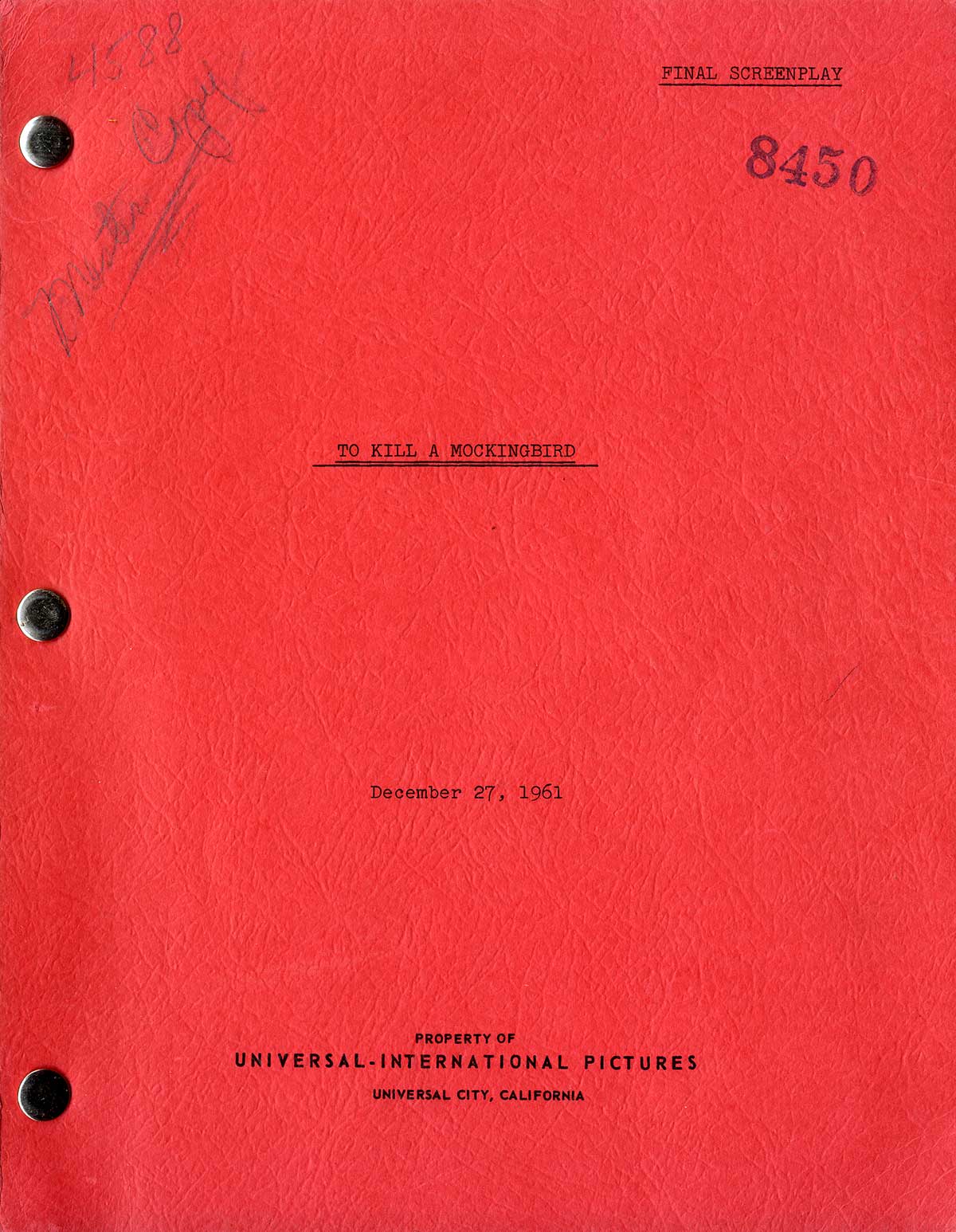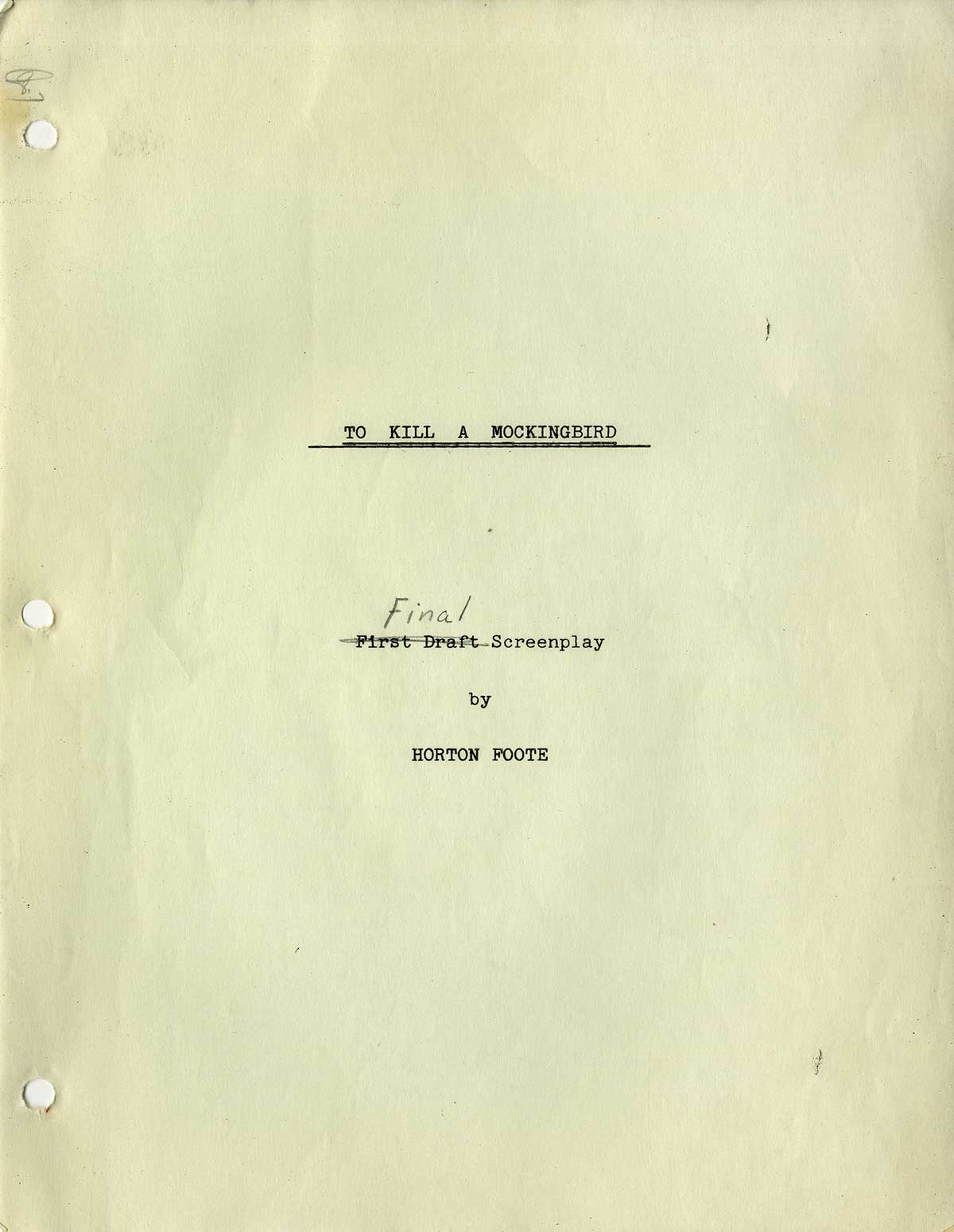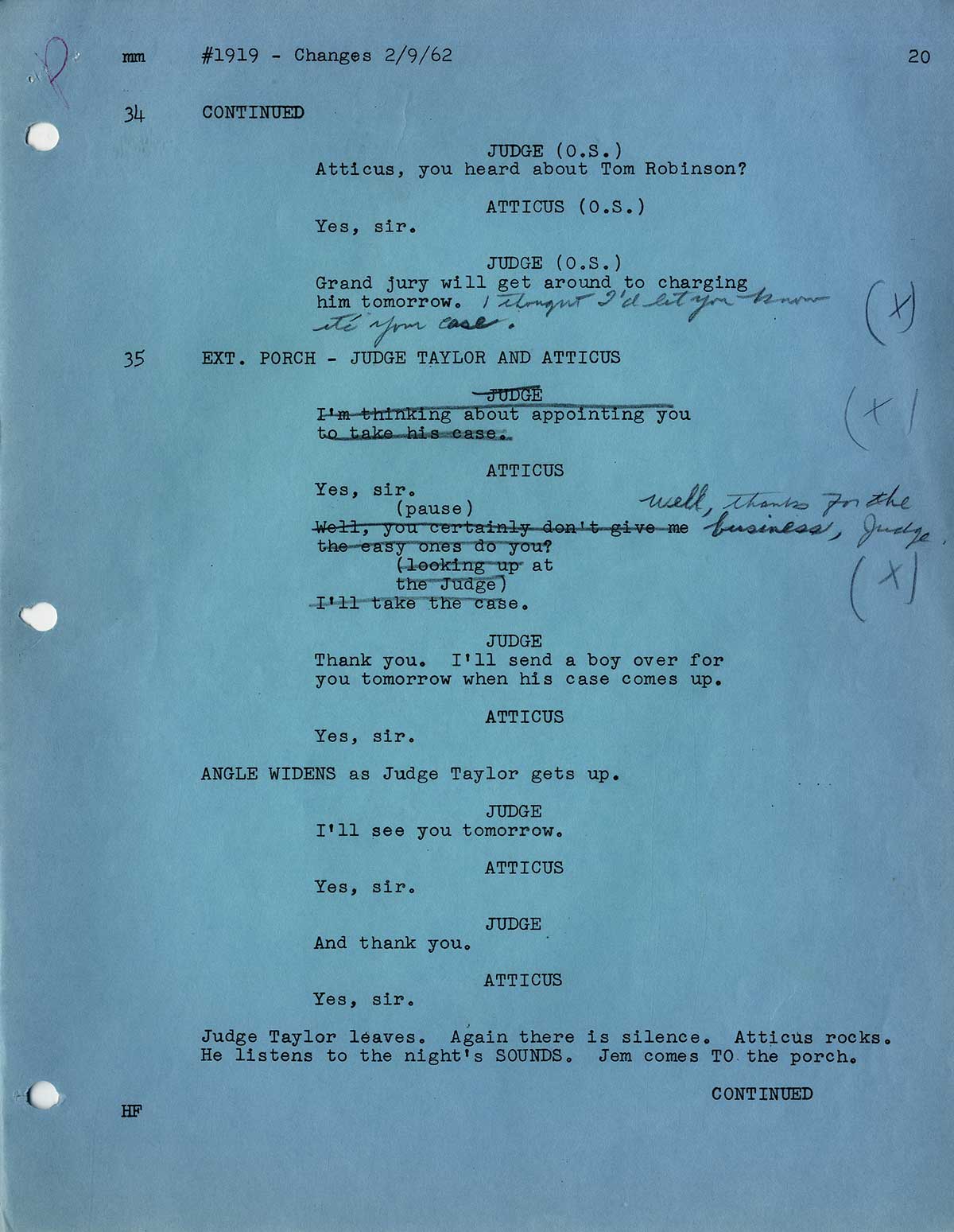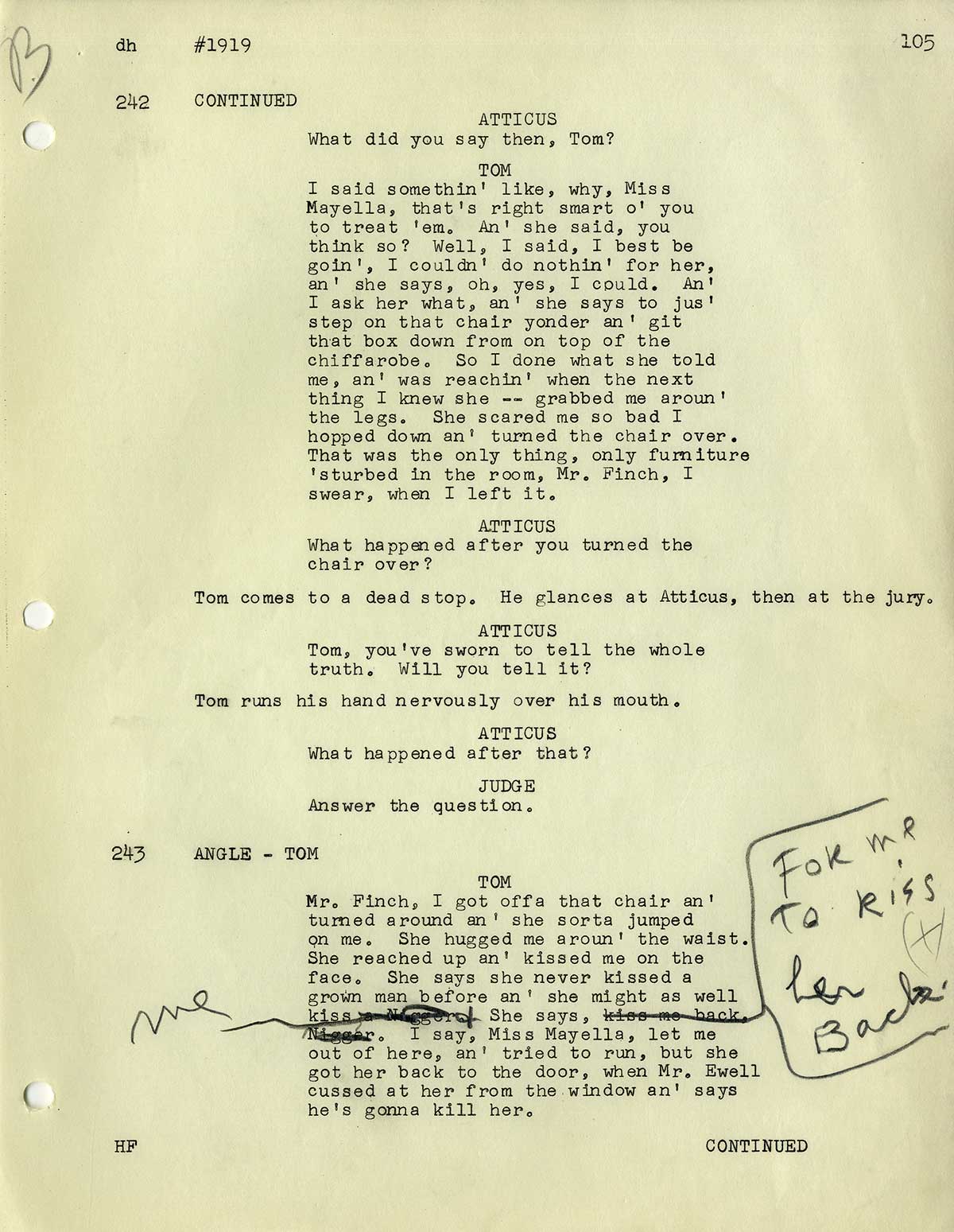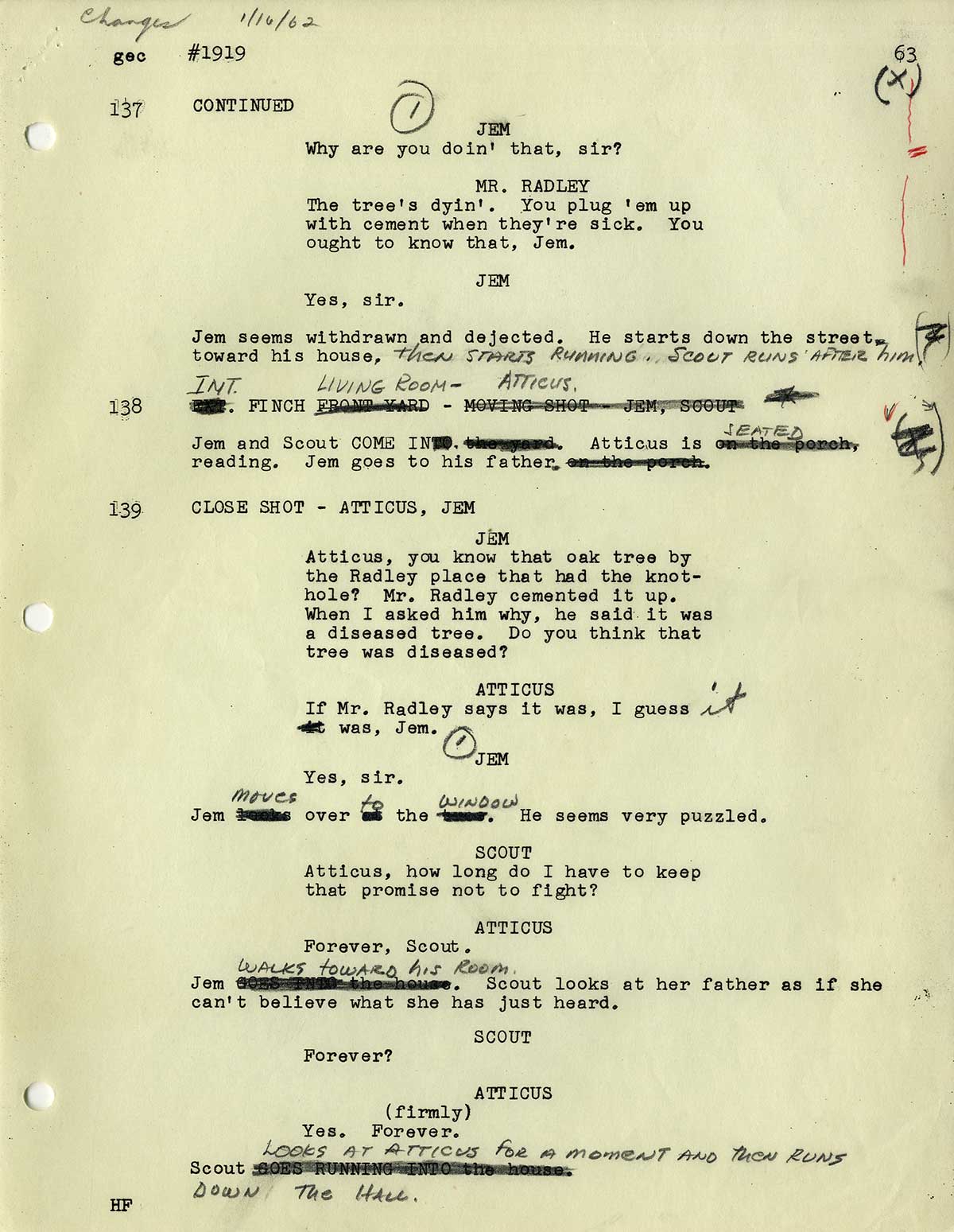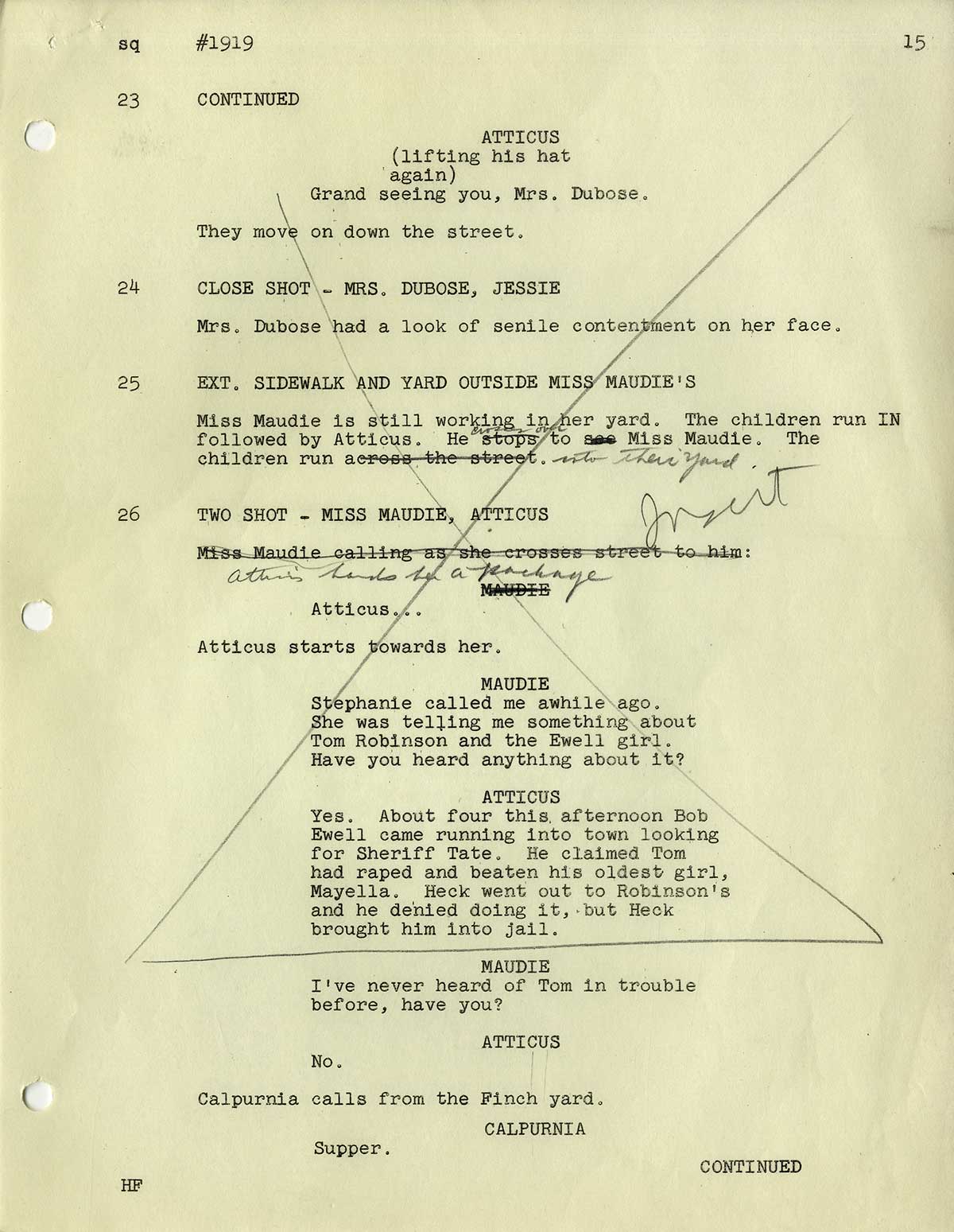TO KILL A MOCKINGBIRD (Dec 27, 1961) Final draft script by Horton Foote
[Hollywood]: Universal Pictures, December 27, 1961. Vintage original film script, 11 x 8 1/2″ (28 x 22 cm.), Printed wrappers, brad bound, quarto, mimeograph, 157 pp. The title page reads “First Draft,” a typo corrected in pencil to read “Final Draft”. One page has a tear repaired with tape. Many pages have markings in pencil. A few have MS revisions to the script. This script contains various typed & dated revisions on yellow onionskin paper, dated from 12/11/61 to 2/6/62.
This is the final draft of Horton Foote’s Academy Award-winning screenplay, adapted from the Pulitzer Prize-winning novel by Harper Lee, an autobiographical story of a white girl with an attorney father growing up in the 1930s in the segregated South.
Nelle Harper Lee was born on April 28, 1926, in Monroeville, Alabama, and died there on February 19, 2016. For years, TO KILL A MOCKINGBIRD was her only published fiction until 2015, when GO SET A WATCHMAN, an alternate draft version of MOCKINGBIRD written in the 1950s, was published as a sequel.
Horton Foote (1916-2009) was another Southern writer, born in Wharton, Texas, and honored in his own right for teleplays like THE TRIP TO BOUNTIFUL (1953 – later, a 1985 movie), original screenplays such as TENDER MERCIES (Bruce Beresford, 1983) for which Foote received an Academy Award, and plays like THE YOUNG MAN FROM ATLANTA for which he received the 1995 Pulitzer Prize for Drama. His nine-play biographical series, THE ORPHANS’ HOME CYCLE (ROOTS IN A PARCHED GROUND, CONVICTS, LILY DALE, THE WIDOW CLAIRE, COURTSHIP, VALENTINE’S DAY, 1918, COUSINS, and THE DEATH OF PAPA) ran in repertory Off-Broadway from 2009 to 2010.
TO KILL A MOCKINGBIRD was the second film made by producer Alan J. Pakula (1928-1998) and director Robert Mulligan (1925-2008), a team who specialized in sensitive films featuring young people as protagonists. Their first film together, FEAR STRIKES OUT (1957) starred Anthony Perkins as a young baseball player battling neurosis. Following their much-acclaimed film version of TO KILL A MOCKINGBIRD, the Pakula/Mulligan team made LOVE WITH THE PROPER STRANGER (1963) starring Steve McQueen and Natalie Wood as young lovers, INSIDE DAISY CLOVER (1965) with Natalie Wood as a teenaged movie star, and UP THE DOWN STAIRCASE (1967) about a young teacher played by Sandy Dennis, and her inner city students in a New York high school. Without Pakula, Mulligan directed the very successful SUMMER OF ’42 (1971), a coming-of-age story set on Nantucket Island during the war, while Pakula became a director himself, with several major films to his credit, including KLUTE (1971), THE PARALLAX VIEW (1974), ALL THE PRESIDENT’S MEN (1976), and SOPHIE’S CHOICE (1982).
This final draft of Foote’s screenplay, notwithstanding some tweaks and revisions, is not substantially different from the completed film — though the film deletes some sequences for the sake of length. Foote’s final draft is essentially a more polished version of his earlier drafts, and includes more indications of camera angles, e.g., in an early scene:
The ANGLE WIDENS as Atticus starts for the front yard to get the morning paper, Scout after him.
Gregory Peck received an Academy Award for playing the role of Atticus Finch, a character based on author Lee’s attorney father, and it remains the role with which the actor is most identified.
The role of friendly neighbor, Miss Maudie Atkinson, is gradually diminished from earlier drafts to the completed film. In the drafts, it is Maudie who first talks about the negro Tom Robinson who allegedly beat and raped the white girl, Mayella Ewell. In the movie, we don’t hear about Tom Robinson (played by Brock Peters) until the town judge shows up on Atticus’s porch one night asking him to take on Tom’s case, essentially marking the beginning of the film’s second act. (In this final draft, the dialogue scene between Atticus and Miss Maudie concerning Tom Robinson has been crossed out with a pencil. The final draft screenplay has numerous duplicate yellow pages marked with pencil to reflect such revisions.)
In the transition from book to first draft screenplay to final draft and completed film, we see an increasingly sharper definition of dramatic structure. The First Act introduces young Scout, her brother Jem, their father Atticus, their friend Dill, and their mysterious unseen neighbor, Boo Radley (the screen debut of Robert Duvall). . The Second and most lengthy Act is about the trial, conviction, and ultimate fate of Tom Robinson as perceived by the children. The Third Act, almost an epilogue, taking place on Halloween some months after the trial, shows the attack on Atticus’s children by the alleged rape victim’s father, Bob Ewell, and how they are rescued by the hitherto-unseen Boo. Discussing his screenplay, screenwriter Foote talked about his efforts to compress the major events of the novel into the space of slightly more than one year. Foote’s screenplay drafts have notably more scenes of exposition and backstory in the form of characters gossiping about each other, than are included in the completed film.
Among the deletions — Scout’s first day in school in Miss Caroline’s class is depicted at length in the screenplay draft (as it is in the book). In the movie, we don’t see it, but only hear about it after Scout gets into a fight with one of the boys from her class after school.
One thematic element that gains increasing importance in the evolution from first draft to final draft to completed film is the gun motif. It first appears on page 6 of the final draft, when older brother Jem complains about his father to neighbor, Miss Maudie:
JEM
He won’t let me have a gun. He’ll only play touch football with me… never tackle.
In every screenplay draft, Jem invites the poor boy, Walter Cunningham, to dinner following his after-school fight with Scout, but only in the final draft does the issue of guns arise during this scene, when Jem learns that the little farmer’s boy, unlike Jem, has his own gun. This leads to one of the most famous exchanges in the movie where Atticus talks about the time his father gave him a gun:
ATTICUS
He told me: “Never point at anything in the house,” and that he’d rather I just shoot tin cans in the back yard. But he said, sooner or later, he supposed, the temptation to go after birds would be too much and to shoot all the blue jays I wanted if I could hit them; but to remember, it was a sin to kill a mockingbird.
JEM
Why?
ATTICUS
Well, I reckon because mockingbirds don’t do anything but make music for us to enjoy. They don’t eat people’s gardens, they don’t nest in corn cribs, they don’t do one thing but sing their hearts out for us…
The gun motif culminates in the disturbing scene where the sheriff enlists the peace-loving Atticus to shoot a rabid dog. Only then does Jem learn that his father is, in fact, the best shot in the County. (The screenplay’s set-up to the dog shooting scene, involving the children and their housekeeper, Calpurnia, is deleted from the completed film. Also cut is a lengthy sequence following the dog-shooting scene where the elderly Mrs. Dubose says that Atticus should be shot like “that dog” for defending a negro, and angry Jem destroys her prized camellia bushes. Atticus, hearing of the incident, makes Jem atone for it by reading to her regularly.)
At the close of the narrative, when the children are rescued from the racist Bob Ewell by their mysterious recluse protector, Boo Radley, it is little Scout who recalls what Atticus said about mockingbirds, explaining why it would be wrong to reveal Boo’s role in Ewell’s death:
SCOUT
Well, it’d be sort of like shootin’ a mockingbird, wouldn’t it?
TO KILL A MOCKINGBIRD is many things simultaneously — it’s a memoir of growing up in the Depression-era South; it’s a Civil Rights story that turns into a courtroom drama; and the treatment of the Boo Radley character adds to the whole story a level of fairytale and myth. Screenwriter Horton Foote’s major accomplishment is to give dramatic shape to the characters and events of Harper Lee’s classic novel while retaining the book’s language, texture, and feeling.
While this was Horton Foote’s first screenplay for a feature film, it remains one of his most impressive achievements — a textbook model of great screenwriting — and in 2018, Lee’s novel was adapted by Aaron Sorkin into a successful Broadway play.
Out of stock
Related products
-
![CHINATOWN [ca. 1973] Jack Nicholson's copy of early draft film script by Robert Towne](https://www.walterfilm.com/wp-content/uploads/2024/06/ChinatownSCR_a-540x693.jpg)
CHINATOWN [ca. 1973] Jack Nicholson’s copy of early draft film script by Robert Towne
$18,500.00 Add to cart -
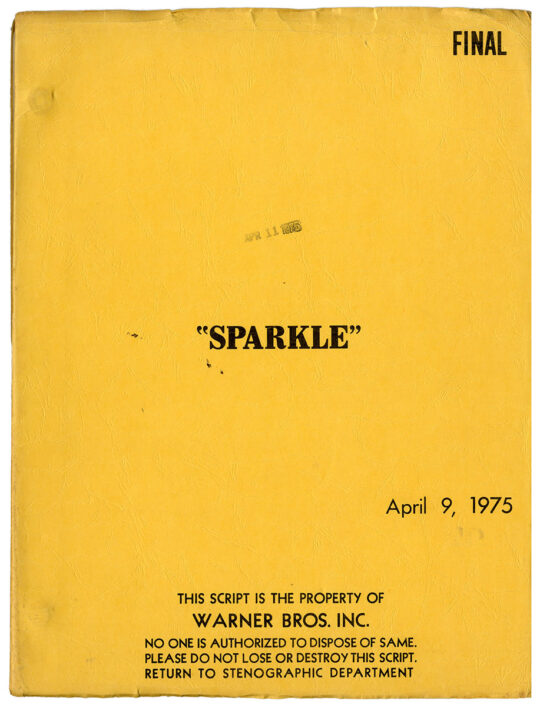
(Blaxploitation film) SPARKLE (Apr 9, 1975) Final Draft film script by Joel Schumacher
$750.00 Add to cart -
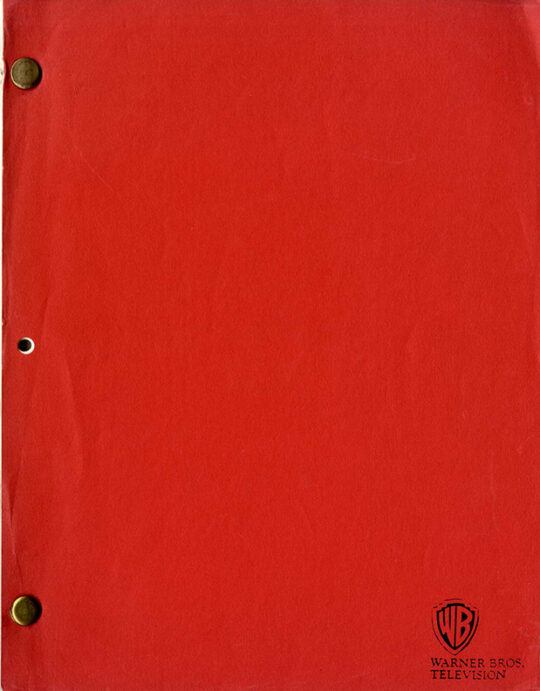
DRESS GRAY (Mar 6, 1981) Second revision script by Gore Vidal
$500.00 Add to cart -
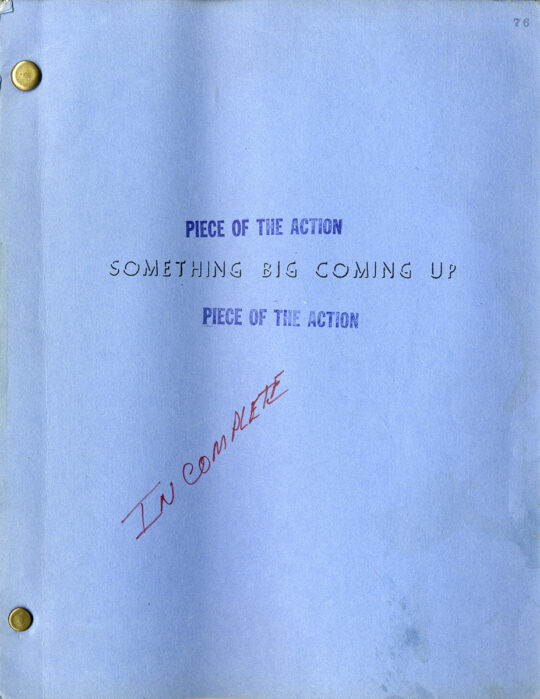
(African American film) A PIECE OF THE ACTION [working title: SOMETHING BIG COMING UP] (Nov 1, 1976) Film script
$750.00 Add to cart

